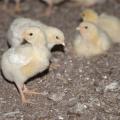Commercial Poultry
The commercial poultry industry in Mississippi has been a leader among all agricultural commodities. The primary income generating phase of the industry, in Mississippi, is the production of broilers. The egg industry provides a substantial contribution to the agricultural economy of our state.
The industry is composed of combinations of integrated poultry companies, contract growers, and independent operators. The poultry industry is emulated by many other agricultural groups as a "trendsetter" for improving efficiency and productivity.
Information presented in this web site includes subjects that are of interest to commercial poultry. These topics often address subjects that extend into nonagricultural areas such as environmental, marketing, and consumer concerns.
Frequently Asked Questions
How much does the commercial poultry industry in Mississippi contribute to our economy?
Mississippi poultry is the premier agricultural industry in Mississippi. The impact of the poultry industry on our state's economy is more than $6.5 billion each year and provided employment to 70,000 Mississippians. No agricultural commodity approaches these contributions of the poultry industry. The industry has consistently ranked among the top three income producing ag commodities for years. Additional economic facts can be found in The Poultry Industry And Its Economic Impact.
What is the recommended method for disposing of dead poultry carcasses?
The proper disposal of poultry carcasses has received much attention in recent years due to the potential effects on environmental pollution. Improper disposal creates an offensive environment, can yield foul odors, attract insects and pests, harbor potential disease sources and contribute to biological water contamination. In response to these hazards, many states have adopted guidelines that eliminate many disposal methods previously used by poultry producers. The only methods of carcass disposal that will be acceptable in Mississippi for the near future will be incineration, composting, and rendering. The most economical method of on-farm disposal for the small poultry producer is composting the carcasses.
What are the fertilizing values of broiler litter?
Broiler litter contains the equivalent of approximately 58-48-37 pounds per ton of N-P2O5 -K2O on a dry basis. This nutrient analysis is the equivalent of a bagged, commercial fertilizer analyzing approximately 3-2.5-2 percent of N-P2O5-K2O, respectively. Based upon current fertilizer prices, broiler litter would be worth about $30 to $40 per ton as a fertilizer, not including spreading and transportation charges.
Broiler litter application rates on pastures of 8 tons per acre and above in a single application have been shown actually to reduce grass growth. Some producers have concerns that applying broiler litter to pastures increases weed production, incorrectly assuming that weed seeds are present in the litter. Increases in weeds in a field receiving broiler litter simply results from the greater concentration of nutrients, which increases the growth rate of all plants and not just weeds in that soil.
Nitrogen in broiler litter is organically bound and is not as readily available as the N in a commercial fertilizer. This slow release of N in broiler litter can be both negative and positive. On the negative side, there is not a rapid growth spurt in forages following litter application, as with commercial fertilizer. On the positive side, litter applications one time per grazing season work well because of the slow release of N that can promote season-long forage growth.
Broiler litter is frequently used as a fertilizer for winter pastures. For optimal results, broiler litter should be applied preplant and incorporated into the soil at a rate of about 4 tons per acre. The N in broiler litter is released slowly in the fall, and the cool and cold temperatures of fall and winter result in an even slower release of N in broiler litter that is organically bound.
Publications
News
BILOXI, Miss. -- Many cattle producers in Mississippi like Bobby Jones do not have access to a dedicated large-animal veterinarian.
Mississippi’s poultry took an estimated 23% loss in value in 2023; though production was strong, a failure to meet the previous year’s record high prices was responsible for the hit. Poultry generated an estimated $3.1 billion to Mississippi agriculture in 2023, down from the $3.9 billion generated in 2022.
Success Stories
She grew up in the 4-H youth development program in Indiana, and her husband was in Ohio 4-H. Fast-forward a few years, and Inez Saum became a volunteer leader for Mississippi 4-H.
The 4-H Poultry Chain Project regularly receives generous donations from organizations across the state, but the project has never received a donation quite like Southern AgCredit’s pledge of $25,000 over 5 years.
Extension helps Okolona producer improve profitability and maintain healthy birds
Joe Ellis knew almost nothing about chickens when he began raising them for Peco Foods, Inc., in 2008.








